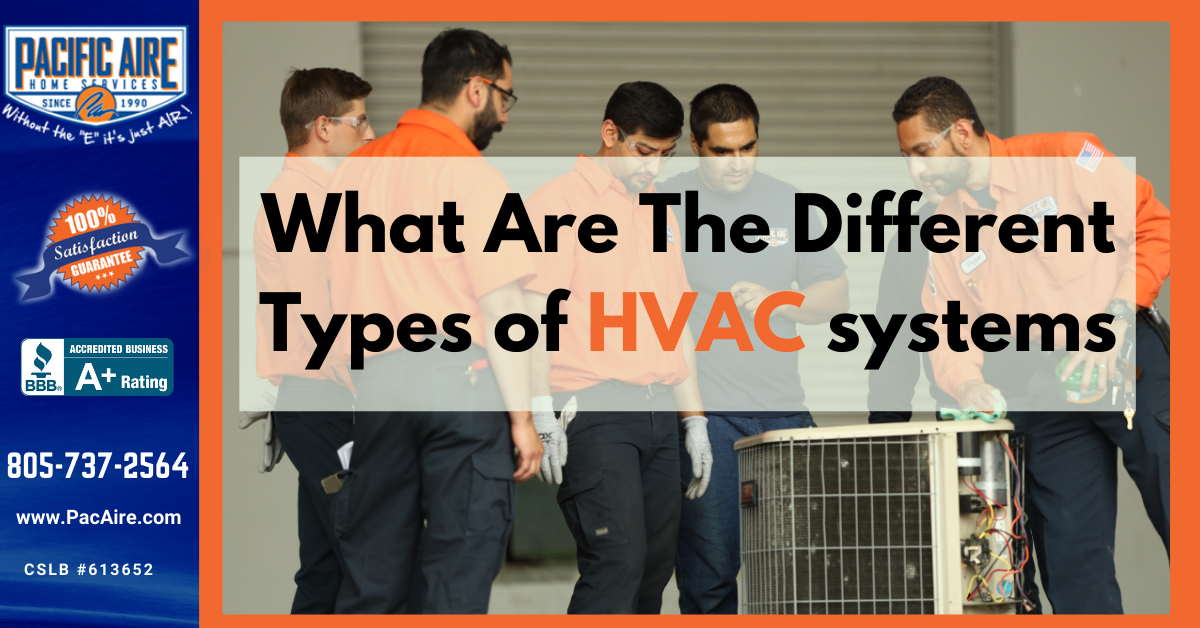Thinking about an HVAC repair or replacement? Different HVAC systems operate differently. They vary in effectiveness depending on the situation. To make a smart decision, familiarize yourself with the types of HVAC systems in your area. Despite homeowners’ perception of air conditioning and heating systems as complicated, it’s actually rather straightforward. Here’s everything you need to know about the different types of heating & air conditioning systems.
The following are the most popular types of HVAC systems:
Hybrid Heat Pump System
A hybrid heat system uses a conventional gas furnace in conjunction with an electric-powered air source heat pump. Heat pumps are more than just a heating system. They can also cool your home.
The furnace in these systems are used when temperatures drop below 40 degrees. Due to the heat pump’s ability to extract heat from outdoor air and transport it inside your home, it is an effective way to heat your home. The air conditioner will cool you in the summer. You’ll have complete energy-savings on just one device throughout the year.
Hybrid heating systems normally include:
- Ductwork for circulating air through your house.
- A thermostat that controls the temperature of the system.
- Extra accessories to enhance indoor air quality.
- A heat pump that heats and cools and comes with a refrigerant.
- A furnace, and an evaporator coil for converting the refrigerant.
Split System
This is the most popular type of central air conditioning. An air conditioning split system consists of two units, one outdoor and one indoor. The outdoor unit contains the condenser and compressor, while the indoor unit contains the evaporator coil and blower. Indoor units are typically attached to a furnace or heat pump.
HVAC split systems typically come with:
- Units that contain air conditioning condenser coils, compressors, electrical components, and fans.
- An evaporator coil located above the furnace in a home.
- A blower that warms the air and sends it over cold evaporator coils to absorb heat from the air.
- Ducts that distribute air within your home. Supply ducts pull air in and return ducts blow it out.
- A thermostat that keeps your house at the temperature you want.
- Refrigerant. It circulates in and out of the unit via an array of pipes or refrigerant lines.
- Other optional accessories for better indoor air quality, such as air scrubbers, air purifiers, humidifiers and UV lamps.
Packaged Heating & Air Conditioning System
The package HVAC has all the components in one unit, unlike split systems where the cold and hot units are separate. The compressor, condenser, and evaporator are all in one unit and are usually located on the roof or on the foundation. It is recommended for homes lacking in space for all the components of split systems.
Packaged HVAC systems usually include:
- Air quality improvers available on request. Air purifiers, cleaners, ventilators, or UV lamps all aim to make the air extra clean before it circulates into your home.
- The air conditioner and the heat pump, as well as the evaporator and the fan coil.
- A thermostat to adjust temperature interface for complete system control.
Ductless Mini-Split Heat Pump
This type of system uses air from one zone to deliver heating and cooling to all the other zones. For every indoor air handling unit, there can be up to four indoor zones or rooms.
For spaces where conventional ducted HVAC systems are incompatible, duct-free HVAC systems offer a solution. If you have an existing HVAC system, they can also be a great complement to it.
The following are usually included in ductless mini-split systems:
- Compact fan coils.
- Wires and tubing, connecting the outdoor unit to the fan coil.
- The heat pump unit that is usually located outdoors and consists of a compressor, condenser, and fan.
- The thermostat which automatically adjusts the temperature or activates a machine when a certain point is reached.
- Optional accessories that help clean and soften the air before it enters your house.


